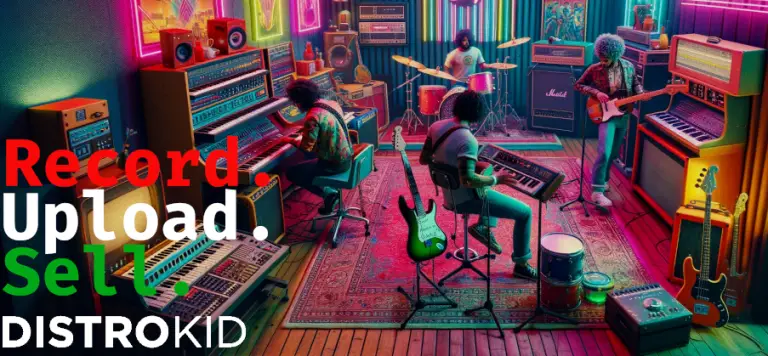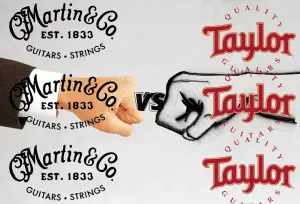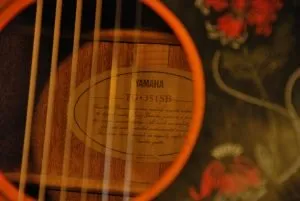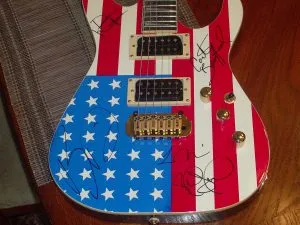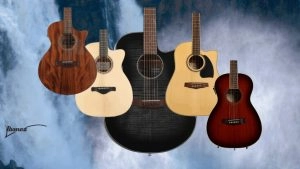If you’re in a hurry, the Baby Taylor BT2e won out as the best choice for small hands overall. Jump down to read more or check it out on Sweetwater here.
The Fender Mustang was the small hands winner in the electric category. Check it out on Sweetwater.
Recently I went searching for the a great guitar for small hands, and was able to get my hands on 5 contenders.
I’ve never had hands that could envelop a fretboard. Other guys were playing these big chunky necked Gibsons with their thumbs muting the E string at the same time they were playing 9th chords. It never felt comfortable. I thought it was me.
Turns out, I wasn’t playing guitars that were suited for the physical size of my hands. After 15 years playing, you come to discover that it’s all about what’s comfortable, and what makes you feel better sitting in the groove. There are a ton of guitars that cater to players with small hands.
But which is the best?

It was a close call between the Martin and the Taylor small scale guitars. In the end, the Taylor edged the Martin out with better onboard electronics, slightly better action, and slightly better price.
When you’re working with a physical condition like smaller hands, you want the rest of the experience to be seamless. You want the instrument to dissolve into you as a player and get out of your way. This is especially important for fingerstyle playing.
Taylor is famous for making guitars that do that, and while the Baby line isn’t their front of house offering, it does what it’s supposed to.
Not every situation calls for the same axe. We can’t all be Willie Nelson.
Once you know that you’re looking for in a guitar for players with small hands, you have to ask yourself what else you’re looking for. Where are you at in your guitar playing journey? Are you looking to rock out on stage with a band, record in a studio, strum some basic chords around a campfire? These are all relevant questions that you’ll need to answer.
Have you considered what you need? No?
Well, read on to take a look at some of what makes the best guitar for small hands on the market today.
Here’s a quick list of the guitars we review in this article. And then we’ll review each one in detail:
And now, let’s review each one of these babies in more detail:
Baby Taylor BT2e – Best Overall Guitar for Small Hands
The Taylor name among guitar players is well known. It’s one of those guitar brands that everyone, almost to a person, wants to own at some point in their journey. The issue that puts most players off from ever owning one is the price tag.
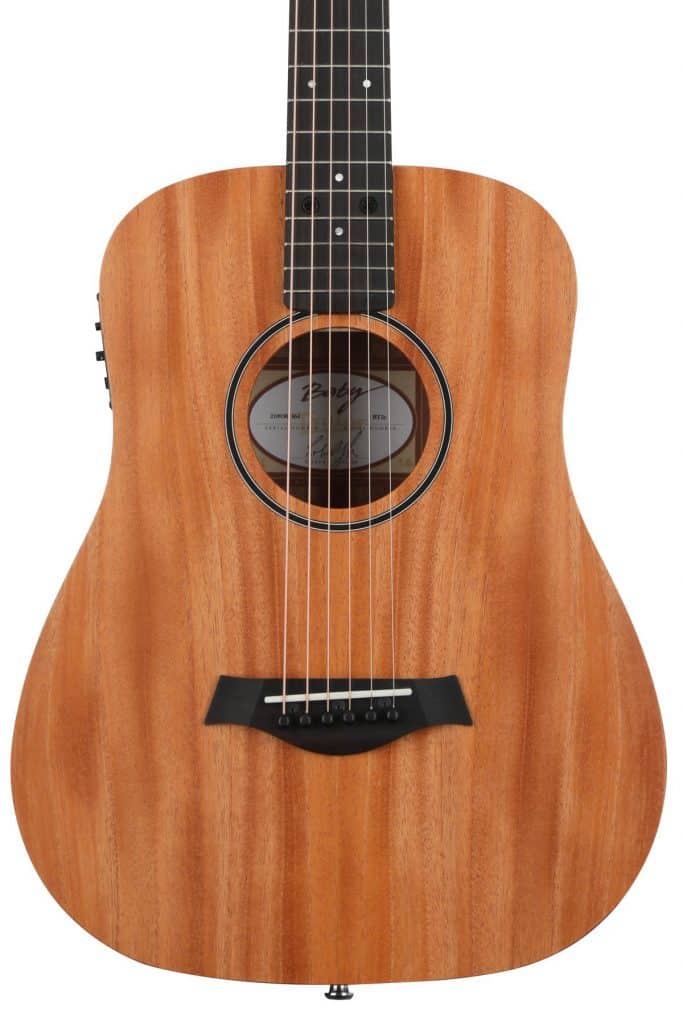
Taylor guitars aren’t cheap.
And when you are bringing a pair of small hands to the party, dropping a month’s rent on a Taylor guitar quickly becomes out of the question altogether. With the ¾ scale Baby Taylor series, the San Diego based guitar manufacturer may well have solved both problems.
Taylor bills this as a travel guitar, or something professionals can use for songwriting. More to the point, the 22 ¾ inch scale means it’s perfect for smaller hands.
Unlike its full-size, top-line cousins, the Baby series has cut some corners on materials, as you’d expect. The soundboard of the guitar, the top, is sitka spruce, so it isn’t going to have the same richness of tone that you might expect from a Taylor.
It’s still a great tone. But it’s just, well, different. For a ¾ scale guitar, the sustain is unbelievable. Part of this excellent sustain and tone is due to the action on this guitar being as low as you’d expect from a Taylor.
- Electronics are unparalleled.
- Excellent action.
- Bright tone.
- Basic materials at mid range price.
- Neck joint.
- Requires regular care.
This guitar also stands out with the Taylor Expression System pickup and preamp. It sits under the saddle of the guitar and is calibrated specifically for the Baby series guitars. There’s a small control panel for tone and volume along with a built in tuner, which is nice to have. No matter the size of your hands.
It’s not perfect by any stretch of the imagination. The material construction does mean you’ll have to pay careful attention to how you store it. And the idea that it’s ready to throw in the overhead bin of your average airline is laughable.
But pick this instrument up, wrap your small hands around its slender neck, and you’ll never set it back down.
• • •
Martin LX 1 – Best for Tiny Singer Songwriters

I’m going to say this more than a few times in this list, but do not get hung up on brands. Martin is a fantastic brand, but as we’ll get to in the Buyer’s Guide, constantly be asking yourself, “is this the right tool for the job?” Don’t bring a saw to a hammer fight.
The Martin LX series, like Taylor’s Baby series is for Taylor, is Martin’s smallest guitar. In fact, the Taylor and Martin tick many of the same boxes when it comes to an unbeatable guitar for small hands.
While the Martin LX 1 might be small in stature, it isn’t small in tone. The sitka spruce soundboard dances when you strum a chord making sure you project each note into the room.
It’s billed as a travel guitar, or an instrument designed for students like many in the class. But, it could easily find itself in that professional songwriter category as well.
The onboard Fishman pickup makes this a great guitar to record direct if you want to do a cover or demo without fussing with setting up a mic. That said, the guitar sounds amazing live, so you should do yourself a favor and read our guide on the best mics for recording acoustic guitar.
The guitar features a modified body shape to slim it down, and the 23” neck scale length with a nut width of only 1.6875” feels comfortable. It’s also printed with a mahogany pattern which makes the neck an honorary mahogany neck. No, it’s not actual mahogany, but come on.
- Custom slim taper body.
- Slightly longer scale.
- Guitar projects beyond its size.
- No onboard tuner.
- Basic materials.
- No tone or volume control.
There’s not a lot in this guitar to dislike. What keeps it from being perfect isn’t what’s included but what’s not there. The lack of an onboard tuner is glaring. It would have been an obvious item to include in a guitar targeted toward students.
Sure, everyone has their phones on them at all times for the app, but why not include it? That said, this is a fantastic entry point to Martin Guitars, which are, of course, spectacular instruments.
• • •
Fender Redondo Player Acoustic – Best for Acoustic Shredders Who Need a Cutaway

The Fender Redondo Player Acoustic is part of Fender’s recent “California” series, where they’re trying to revive some of the fun, unusual, cosmetic aspects of the acoustic guitars the company produced in the 60s. And wow, have they succeeded. These are moderately priced works of art. Like a Picasso near the end of his career, but, you know, tone worthy.
Aside from being aesthetically fun, these guitars also aim to bridge the divide between traditional acoustic dreadnoughts and their electric solid body guitars. Such as the Stratocaster.
What this means for players with small hands is that the California series features the Strat C-shaped neck.
I tend to play my older Fender Catalina acoustic because the thinner C-shaped neck allows my hands to move around the neck with ease.
Most regular full-size dreadnought acoustics feature a chunkier neck that feels noticeably bigger in your hand. It’s the difference between holding a tangerine versus an orange.
Within the California series, the Redondo has the widest range of features and thus the widest range of potential players. In addition to the onboard pickup and tuner, the Redondo has a full-size body for full-size sound.
It also has a cutaway, so players have access to the higher frets for working on lead parts. Which may not seem like a major consideration, but tell that to Mr. Clapton.
If you’re looking to straddle the acoustic and electric worlds, it’d be hard to go wrong with the California series, and specifically, the Redondo.
Do take a look at a few of the other California series acoustics. They have similar feels, but the body shapes differ enough that you may find a better personal fit.
- Has a cutaway.
- Looks cool.
- Slim electric C-shaped neck.
- Not a short scale.
- Middling electronics.
• • •
Fender Player Mustang – Best for Small Hand Rock Stars
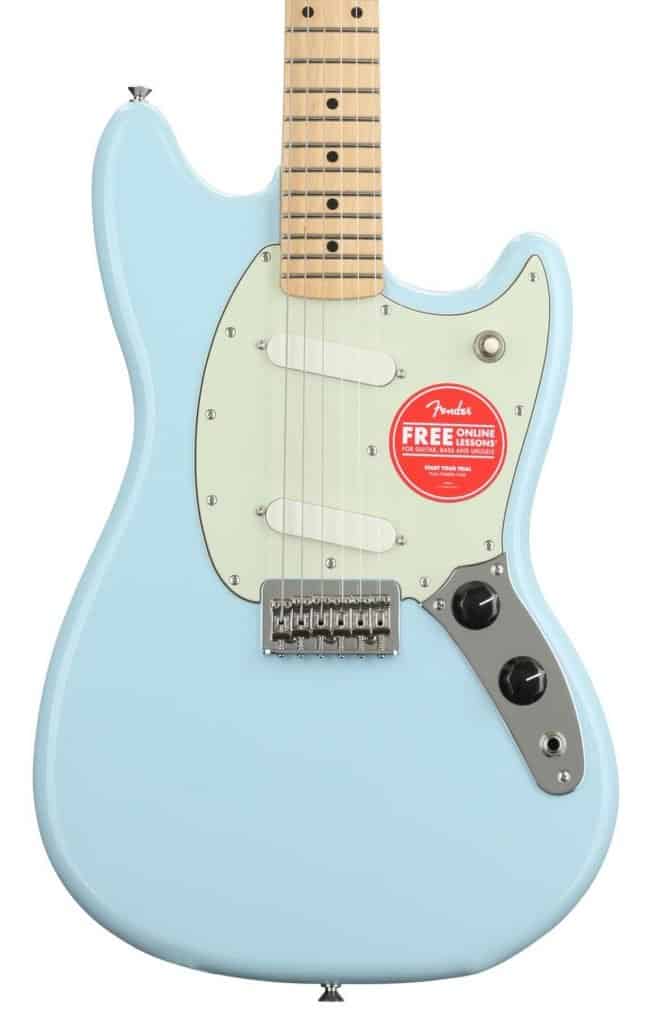
The Fender Mustang guitar shape was introduced in 1961 when Fender was reworking their entire line of student guitars. These would include the Musicmaster and the Duo Sonic ¾ scale guitars.
Fender dreamed up the Mustang body after they held competitions for kids. They saw kids playing Teles and Strats that were enormous compared to the kid’s diminutive size. So, the 22” scale and ¾ size guitars were specifically made for players with small hands.
The result is a guitar that’s a lot of fun to play, well made, and relatively inexpensive. This trio of features made the Mustang’s reintroduction a welcome addition to the 90s alternative rock scene.
It became a favorite amongst female fronted bands as well because it was of such high quality.
On my most recent visit, I played the recently introduced player series Mustang, but this isn’t my first rodeo with this particular horse.
- Mexican made
- Hardtail bridge to adjust intonation
- Updated player series pickups
- Player series doesn't have phase switches
- No tremolo
The model I tested had two single coils which was standard. But these days you can get just about any pickup configuration you’d like.
Squier also has brought the Mustang’s physical form factor back for small hands at an even more attractive entry-level price.
• • •
Epiphone SG Special – Best Budget Electric for Small Hands
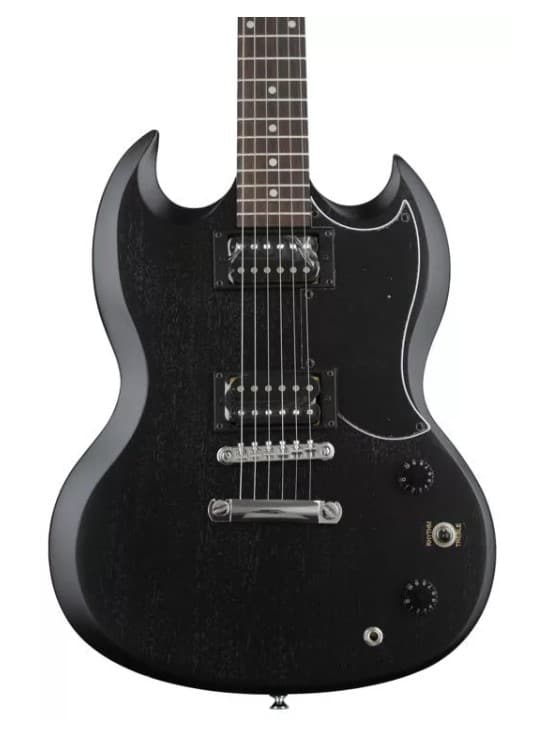
The Epiphone SG Special is a lot of guitar for very little money.
The SG got its name once Les Paul stopped working on the project (1). It was rebranded SG for “solid guitar.” Not the most innovative name in guitar history, I’ll grant you. But as soon as Gibson relegated the SG to second-class status, it became an accessible entry point into the Gibson ecosystem.
Much like the Les Paul that followed, the SG has two humbuckers, a 24 inch scale, and the best Tune-O-Matic bridge in the business. It allows players to dial in the distance between the strings and the rosewood fretboard, also known as the “action.”
It’s this action adjustability along with the lightweight double-cutaway body that makes it a great guitar for smaller players. The action is also a place a lot of manufacturers fall down when producing a cheaper version of their top-of-the-line instruments.
That wasn’t the case at all with the Epiphone SG Special I sampled. My fear that the action would be too high and thus uncomfortable for small hands was completely misplaced.
- Price.
- Adjustable action.
- Many Epiphone SG variants.
- Body weight and center of gravity takes some getting used to.
- Not great for sitting down.
When you pair the excellent action with the shallow D-shaped neck on the SG, it lets even the smallest hands fly around the fretboard. It’s similar in feel to the C-shaped action you’ll find on many of the Fender and Squier guitars we’ve looked at. Slightly beefier, but not so much as to cause a notable difference in comfort for even the Trumpiest of hands.
This cheap little guitar played like a dream.
• • •
Gibson Standard ‘61 SG – Best Well Appointed Electric Guitars for Small Hands

When you’re shopping for permanent electric guitars for small hands, it’s tough to beat the quality of the Gibson SG. It shares the same slim neck and lightweight guitar body as its far cheaper Epiphone cousin, but the build quality is off the charts, making it one of the best guitars on any list.
The Gibson model also steps up the electronics on this guitar, giving each humbucker independent volume and tone controls in line with the Gibson Les Paul. The thin neck, with a 24.75” scale length, is also integrated into the body instead of being bolted on, and the rosewood fingerboard features plek’d frets, meaning it’s one of the most comfortable fretboards you’ll ever own.
This model is a reissue of the 1961 design, the first year the SG was widely available. With that 61 feel comes the nitro finish, small pickguard, Tune-O-Matic bridge, and black hat control knobs. It also features a blank truss rod cover, which would be one of the few years Gibson would go this route.
This is a forever guitar for anyone, but easily one of the best guitars for small players.
- First issue of this legendary guitar
- Neck-through design increases tuning stability
- Price can be a turn-off for a first guitar
• • •
Yamaha APXT2 3/4-size Thin-line Cutaway – Best Acoustic Guitar for Travelers

Just because this Yamaha is a small guitar that doesn’t mean it lacks the sound of a full-sized guitar. The smaller guitar body makes it a great choice for smaller players, but it is also a great traveler guitar. Full-sized guitars are a pain to travel with and always have to be checked. This one can fit in the overhead as a carry-on. Which is a real consideration for an acoustic guitar.
This is a cheap guitar, but it includes a lot of extra features. The onboard electronics mean you can get a full-sized sound with a smaller body. Yamaha included a built-in tuner as well, so staying in tune is never a problem.
The APXT2 is based on another Yamaha model, the popular APTX500. Like its big brother, the APTX2 has a rosewood fretboard and 22.81” scale length, and low action that makes playing chords a delight.
- Great value for money
- Onboard electronics, tuner, and pickup.
- Smaller body has many applications.
- Tonewood is used for the back and sides to reduce cost.
This might be the right guitar for any collection. If you have limited space, often find yourself in airports, or are a songwriter who doesn’t want to break out a full-size guitar, then a smaller guitar like the APTX2 is a solid player.
• • •
Squier Mini Strat Electric Guitar – Best Electric Guitar for Travelers

The Squier Mini Strat is one of the tremendous electric guitars for small players coming out of Fender’s various factories. It travels well too. Unlike the Squier Bullet series, the Mini Strat has a smaller body that’s about ¾ the size of a standard Strat, yet it retains that Squier classic vibe.
It features the standard three single coil pickups, but simplifies the electronics a bit, opting for a master volume and tone knob. If you’re a kid or just starting out, the idea of a 5-way switch with two tone knobs for 3 single coils is a bit of a confusing proposition to begin with. Honestly, I’m fine with the simplification.
Many guitars in this class opt for a rosewood fingerboard or even a maple fretboard, but Squier has gone with an Indian Laurel hardwood on top of a thin neck that makes this guitar unique. And that Indian Laurel is sitting atop a genuine maple neck.
- Shorter scale length makes playing guitar easier
- Small guitar that is a superb travel companion
- Squier classic vibe without cutting corners.
- Tone control simplification may be a turn-off for tone junkies.
- Solid tail bridge and no whammy bar.
With the Mini Strat, Squier opted to simplify a strat without cutting corners. Guitar players of all skill levels appreciate this.
Newer guitar players will also appreciate the 22.75” scale length, which makes handling bends much easier. This is one of the best electric guitars for any collection. You don’t always need a full-size guitar, and this is one of the best guitars for small applications.
• • •
Jackson Dinky Arch Top JS32 DKA – Amazing Electric Guitar to Introduce Metal/Hard Rock

Jackson is an electric guitar manufacturer I overlooked for a long time. And only to my detriment. Lately, I have been on a huge Jackson guitars run after having the opportunity to play this JS32 at a recent jam session. Literally one of the most comfortable electric guitars I’ve played.
Lesson learned. Keep an open mind and play guitars you may not normally play. Generally a good life lesson in any context.
What makes the JS32 guitars great for small hands is the “speed” maple neck. It’s a slim neck and naturally fast. It feels like you need little to no finger strength to make this thing sound amazing. The scale length is slightly longer than some of the other guitars on this list, but small-handed players won’t notice despite the 25.5” scale length.
- Slender neck makes the JS32 perfect for small hands
- High output humbuckers are born for hard rock
- Supremely affordable entry into Jackson
- You might need to turn your amp down.
The sharp double-cutaway body makes it easy to dance around all 24 frets. Combine that with the two high-output humbuckers Jackson has included, and this may be your foray into the metal world. At this affordable price, it may be one of the best electric guitars for hard rock.
• • •
Charvel Pro-Mod So-Cal Style 2 – Best Versatile Metal Guitar

This guitar is gorgeous right off the bat. Its Telecaster style is laden with Charvel’s metal attitude. The natural ash finish on the body is beautiful. Even if you can’t play a lick, you’re going to get some attention. Use it wisely.
A 24 fret and 25” neck scale length adorn a toasted maple fretboard and caramelized maple neck. It features a reverse headstock which some players have had issues with when storing the guitar. It turns out that it isn’t compatible with some racks and mounts.
What makes this metal beast shine is the pickups and electronics. Inside the body are two Fluence Open Core Humbuckers by Fishman that allow a player to switch between three settings for each pickup.
- Stunning instrument to look at.
- Onboard electronics offer a wide variety of possible tones.
- Some players have returned this instrument as it was difficult to store in their home rack.
Everything from single-coil twang to the hottest metal PAF humbucker. The mechanism for switching settings is lifting the pot knob that controls the volume of each individual pickup. That means it can be done quickly and on the fly. Perfect for on-stage aural wizardry.
The only real downside is that designers can sometimes go overboard with the physical changes that make the guitar impractical. From reading the reviews, that might be the case here.
• • •
Fender American Professional II Stratocaster – Best American Made Stratocaster

We took a look at this guitar as one of the best American-made guitars and I made reference to this being the Stratocaster that Prince would own. Now, Prince wasn’t a big guy by any means other than his outsized talent.
I’m not going to say Prince was concerned about his size, and we all know he could ball like none other, but those were pretty big heels on those boots.
Thus, it’s important to note what makes this a contender for smaller players. Right away, the deep C neck stands out as making playing an absolute treat. Inspired by the Fender Custom Shop, it’s a neck you won’t see on any Strat you didn’t custom order. This Strat obviously has the same double cutaway and contours on the alder body that make it a dream to play.
- The gold standard coming out of Fender’s American factories.
- C shaped neck is comfortable for smaller players.
- Electronics are bell-tone clear without an ounce of hum.
- Could be considered pricey.
- Longer-scale length can require some extra session time for smaller players.
It’s that neck that really stands out for smaller players. It’s available with a maple neck and a maple or rosewood fingerboard. The rosewood fretboard provides a slightly softer, mellower sound.
With a 25.5” scale length and a nut width of 1.685”, smaller players will need to do some stretching. Although any excuse to put some extra time in on this guitar is a no-brainer.
• • •
Fender American Acoustasonic Stratocaster – Best Hybrid Guitar

The minds at Fender are always thinking about moving their electric guitar dominance into acoustic guitars. The Acoustasonic Strat is a true hybrid instrument, but it isn’t the first time Fender has taken their iconic electric guitar body to the acoustic guitar world.
The Stratacustic hit the market in 2000, aiming to bring the feel of an electric guitar to acoustic players. With middling success, the instrument was discontinued in 2005.
The Acoustasoinc Stratocaster is a different beast altogether. It seamlessly combines an acoustic guitar with an electric guitar. The solid Sitka spruce top lets the guitar resonate, and the mahogany neck lets you play guitar like a normal strat, making it one of the nicer guitars for small hands.
- True blend of an electric guitar experience with an acoustic guitar experience.
- Solid Sitka spruce top produces an excellent acoustic tone.
- Onboard electronics have various Fender acoustic guitar tones built in
- At the upper end of the price scale.
- Longer scale length will require more finger strength
A noiseless single coil at the bridge echoes true electric guitars, and the Fishman middle piezo pickup brings the acoustic guitar sound to life. Even if you play guitar professionally, you haven’t run into a hybrid like this before.
The electronics for this acoustic-electric guitar hybrid are powered by a rechargeable USB battery with a 20-hour life, so you shouldn’t run into any problems there. Plus, it has a decent sound completely unplugged for when you forget to charge it.
That will happen. Be prepared.
• • •
Ibanez PN1 – Best Affordable Parlor Guitar for Outerspace

Ibanez guitars are most known for their metal prowess, but that doesn’t mean they don’t make some interesting acoustic guitars, including this parlor guitar.
What stands out about parlor guitars is their obviously smaller body, which can increase their playability factor. And because they’re smaller, they can go just about anywhere.
If you haven’t seen astronaut Chris Hatfield cover David Bowie while on the International Space Station, you’re missing out.
With a mahogany neck and high-gloss solid spruce top, this instrument really stands out. It uniquely features a nandu fretboard that most other guitars don’t use very often. What stands out most about this Ibanez is the price.
- Affordable entry into the Parlor world.
- Unique tonewoods add to the guitar’s resonance.
- No onboard electronics.
- 24” scale length can take some getting used to.
Overall, parlor guitars sound great and project well, with a mid-range tone that is perfect for singing along with. This one is versatile and oh so affordable, which makes it hard not to pick one up. If you’re a player, small hands or not, with any travel on the horizon, buy one of these. You’ll thank me
• • •
Squier Classic Vibe 70’s Stratocaster – Best Affordable Vintage Guitar for Little Hands

I have such fond memories of walking into a guitar store and picking up a guitar I thought I could afford, playing a forbidden lick, and kindly (or not so kindly) being asked to beat it. I was a teenager with solid mahogany dreams on a basswood budget.
Hence my introduction to Squier. Now, Squier can get a bad rap, but since the late 90s, they’ve been churning out absolutely excellent guitars that are stage-ready out of the box. This 70’s Stratocaster is no exception. And remember, unless you’re Billy Corgan, the CBS-era Fenders don’t have a great reputation. Gish, pish, posh.
Luckily for us, this isn’t the CBS era.
This guitar features three Fender Alinco Single Coil pickups, a vintage 70’s “big headstock,” a 25.5” scale length, and a nut width (real bone, by the way) reaching 1.650”.
- Affordable quality from Squier
- Vast improvement on the CBS era Fenders.
- Having to explain to your bandmates why you chose a Squier.
This guitar is approachable if you’re just starting out as well. Sure, it doesn’t have the alder neck or mahogany body we all pined for (pun), but do we really need a mahogany body? Poplar is fine. This guitar is a beauty with its laurel fretboard and 70’s vibe.
• • •
Loog Guitars – Guitars to Help Kids Get Started

Loog is a class unto itself. Their philosophy is every child can learn to play the guitar, and they have various models to make playing guitar as natural as possible.
The electric guitar and acoustic guitar they produce are extremely high quality and are designed for children as young as three years old. Now, three-year-olds have some pretty small hands, so, to compensate, their smallest guitars feature only the first three strings. G-B-E.
Nylon strings (like classical guitars), a 15-inch scale length, and a maple fretboard are specifically designed for tiny, soft hands. And not just for kids, but for any new player that might include parents or grandparents.
They are a version of classical guitar meant to fill the role a ukelele has in learning music. By learning chords on a Loog guitar, the skills directly translate to playing guitar on a full-size instrument later on.
Loog has the 3-string acoustic, a 3-string electric, and six-strings in both short-scale acoustics and electrics. It’s more of a guitar learning system for players with small hands. It’s a new concept that borrows from Fender’s tradition of “student” guitars like the Mustang and Duo Sonic.
- Inexpensive
- Lessons and flashcards are included to teach music theory
- Many models available, including six-strings.
- Materials aren’t the best in the world. No solid mahogany or solid spruce top here.
But it takes the idea even further than Fender’s engineers thought possible. In fact, Loog boasts that players can play “a song” on the first day. Progress, not perfection, as they say. Because having some semblance of progress is integral to keeping players going.
Lessons and flashcards are included making this a no-brainer package for any person interested in learning guitar.
A Little Martin acoustic guitar can be expensive and confusing when you’re first learning to play. Loog helps teach theory and playing at the same time.
• • •
Buyer’s Guide
The Taylor BT2e is my my choice for the all around best choice for small hands. It ticks the most boxes for the widest range of players. It’s a nice instrument for just about any collection, especially for those who are finger-length challenged.
The Mustang is my choice for best electric guitar for small hands. You aren’t “making do” with the Fender Mustang. It was designed to solve this specific problem. Smaller artists the world over count this guitar as their go-to, and for good reason.
But it may not be the best guitar for every use case. So you have to work your way through the gear buying guide to figure out which is the axe for you right now.
Knowing full well you can come back here for another round of gear buying.
What Type of Player Are You?

In other words, what type of music do you play? What do you like? Are you gigging out, or playing at home? Do you have all the time in the world to get a riff right, or do you need that ease of play, every time, that a well fitted guitar provides?
Remember, you don’t wear an untailored garment. Or, at least you shouldn’t. C’mon. It’s far past time to get your nice clothes tailored.
Depending on where you’re at in your journey, you may not know yet, and that’s okay. As soon as you can, dig deep. It’s a coming of age story for every player. When they settle into their groove, and start making their art.
Most players, even the heaviest metalheads, will need a solid acoustic in their arsenal. Which is why the Taylor found its way to the top of the heap. You may not have thought so, but then you see the success of “Nothing Else Matters,” and you’re a changed player. Maybe you’re not giving up the gain, but you recognize the need for your songs to sound good on acoustic as well as heavily overdriven.
The next question is what do you need as a player?
What Are You Using This For?

Are you writing songs? Strumming chords at home for fun? Are you in need of a live guitar you can play standing up instead of sitting down? Do you need little martin guitars, or can you get by with a Yamaha? I’ll stress again, don’t get hung up on brand names. Yes, they are ususally indicative of quality, but getting wedded to a single brand or a single style can really put a damper on your musical horizons.
The specific use case will help dial in exactly what you need. Again, the Taylor will get you there 80% of the time, but on occasion you need to crank it up to 11 live.
For that, check out the SG.
Is This a Forever Guitar?
There are a lot of compelling reasons not to skimp on your guitar.
In fact, we have a whole article covering $1,000 guitars that just make a lot of sense.

Not too many of these these guitars cost that much, but they aren’t cheap either. Even though smaller guitars are often billed as travel guitars, that does not mean they can take extra abuse.
It’s all about finding the right tool for the job and then treating that tool with respect. Before you buy, make sure you know what’s required for upkeep and maintenance. There’s nothing worse than seeing an old, moldy, decaying instrument suffering from years of neglect. Remember, they are wood, they are organic. They will decay if left unattended.
• • •
Frequently Asked Questions
If you still have questions about how to choose a guitar for small hands that strikes a chord with you, read on. You’re likely to find answers in this section.
Can your hands be too small for guitar?
No, your hands, generally speaking, can not be too small for guitar. You may need to do some additional work stretching your fingers and may need to choose the right guitar. You may find some guitars uncomfortable to play, and life is definitely too short to be frustrated and uninspired because you feel uncomfortable. Like a bad pair of jockey shorts. Or an ill-fitting bra. No, we’re not going to take it.

Here’s a trick to work your hands. Practice playing barre chords on bass. If you can play barre chords on bass guitar, then moving back to a guitar neck is going to feel like a breeze. I honestly never thought I’d be able to play a simple power chord, but after a while of sitting at “band” practice, working this technique, it clicked.
Tip number two, be sure to pay attention to the nut width. This is where the strings are hardest to push down, so smaller players will appreciate a thinner nut width. Ask anyone with bigger fingers and a smaller nut is an enormous hassle.
Better yet, go get yourself a classical guitar to mess around with. Small hands will certainly come into play there.
Do you need big hands to play guitar?
No, you do not need big hands to play guitar. You just need to find a guitar that is comfortable in your hands. Every player is unique and will find an instrument that fits like a glove and sounds fantastic.
Don’t get hung up on brands, and feel empowered to venture into uncharted territory to find the instrument you need to play comfortably. Ask yourself, do I need a Martin acoustic guitar that may be comfortable in my hands, or will the parlor suffice?
What guitar neck is best for small hands?
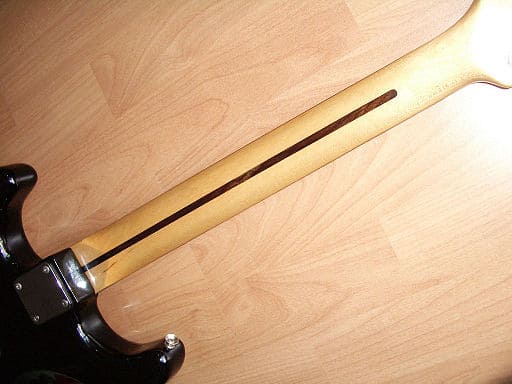
Generally, a C-shaped guitar neck is best for small hands. The flatter the shape, the easier it is for small hands to wrap around it.
It’s one of the main reasons we have focused so heavily on C-shaped necks and “Speed Necks” — which are variations on the C shape designed to let your fingers fly on the fretboard— in this article, regardless of scale length.
Are Gretch Guitars Good for Small Hands?
At the lower end of the spectrum, Gretch guitars aren’t good for small hands. The opposite is true for the higher end of the price spectrum. Cheaper Gretch guitars have very bulky necks and high actions, which make them difficult to fret for new players as well as those with small hands.
The exceptions to this opinion are their higher-end electric models and their excellent retro Parlor guitars. In fact, Gretch’s Parlor models are some of the best on the market. Not the cheapest, but if you can afford the price tag, the styling and tone are unbeatable.
Are SG Guitars Good for Small Hands?
Without a doubt, SG guitars are good for small hands. Have you seen Angus Young? Best-selling rock record on the planet, and the man has never wavered in his choice of guitar. And there’s a reason he’s still wearing a schoolboy uniform to this day… he’s not a big guy.
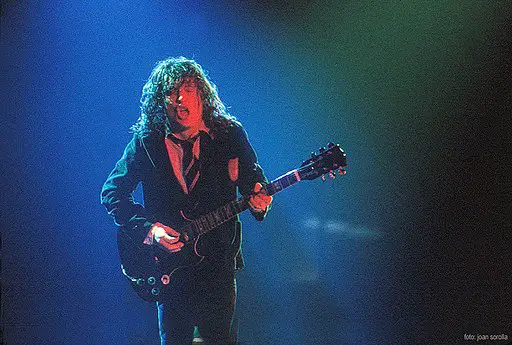
A rock guitar god? Yes. Someone who’s destined to be one of Australia’s best rugby players? No. We all have our lot in life; let’s recognize that. As for the SG, they knew what they were doing when they produced this hard-rock, evil-looking, double-cutaway guitar.
The scale length is perfect, and the choices are endless, from bolt-on necks and open humbuckers to a mahogany neck-through design. They’re just an excellent, widely available choice.
How to Get Better at Guitar With Small Hands
You get better at guitar with small hands by practicing. Sorry future shredders, there’s no silver bullet here. You’re learning to hone your use of a precision tool… you’re going to just have to grind it out. Find a guitar that feels comfortable, do your stretches, and find music you want to play.
But at the end of the day, you have to put in the work.
• • •
Conclusion
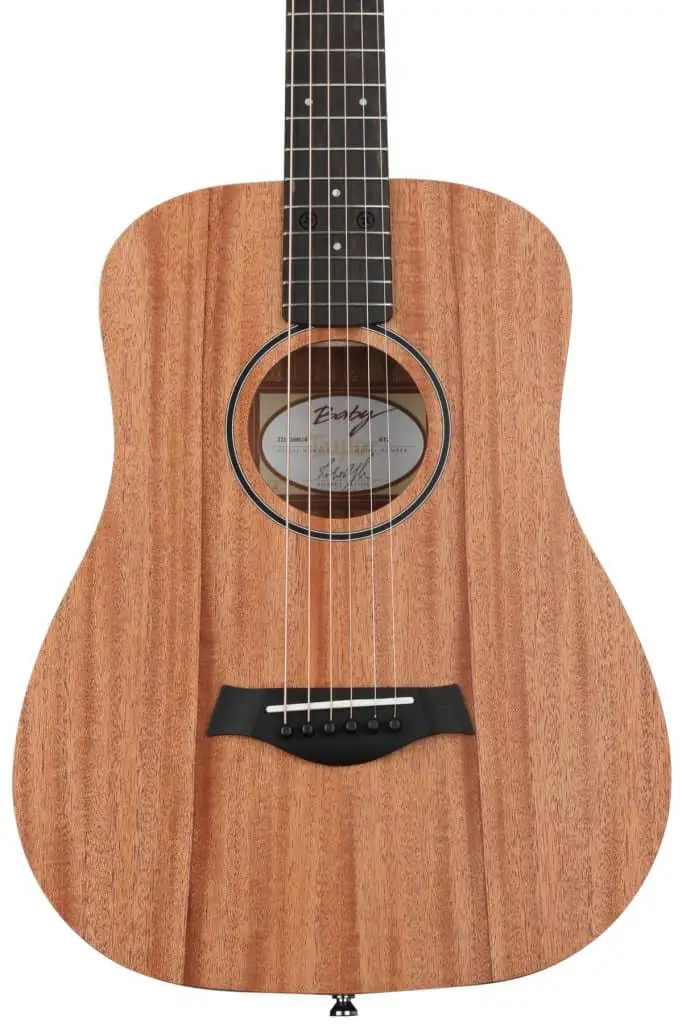
The Baby Taylor BT2e is the best option for small hands. It plays beautifully, sounds like a dream and doesn’t break the bank.
The onboard electronics are well thought out and a step above everything else in its class. With most cheaper acoustics, the pickup is an afterthought, but here the system is tuned to this specific model.
If you take care of it, the Baby Taylor BT2e will treat those tiny hands right for years to come.

When you want to crank up the volume and rock out, you’ll be in good company selecting the Fender Mustang. It’s the electric designed for the job and the electronic configuration options make it the obvious choice for almost any genre. The shorter scale length and student inspiration make it the obvious choice for diminutive hands.
Any SG model on this list is a close second to the Fender Mustang. If you require more output, it might even put that SG higher on the list than the Mustang. It comes down to the right tool for the right job, and again, every player creating their own art is unique.
Your hand size is unique. Your art is unique. You have to find the right tool for the right job. Just as Michaelangelo found the right chisel for sculpting David, or Michelangelo found the right nunchucks for beating off foot soldiers. Perspective is everything.
Don’t spend another day playing a guitar that wasn’t meant for your hands. Click on over and take a look at everything small hands can do.
• • •
References:
- Rod Brakes, “The history of the Gibson SG,” as published here https://www.guitarworld.com/features/the-history-of-the-gibson-sg
Image Credits
Guitar neck image: Detlev Dördelmann (Wickler), CC BY-SA 2.0 DE, via Wikimedia Commons; Angus Young image: Joan Sorolla from La Roca del Vallès, Catalonia, CC BY 2.0, via Wikimedia Commons.


